On the seventh day of Christmas, my true love sent to me,
Seven swans a-swimming,
Six geese a-laying,
Five gold rings,
Four calling birds,
Three French hens,
Two turtle doves,
And a partridge in a pear tree.—“The Twelve Days of Christmas”
I’ve decided to do something slightly different for this post. I’ll be using seven examples of swimwear from the V&A’s textiles and fashion collection to point up some key aspects of the history of women’s swimwear. Most of the objects pictured below are currently in the Clothworkers’ Centre and available for appointments, but numbers 2 and 3 are on display in the Museum.
1) Bathing Costume T.336&A-1987, ca. 1910
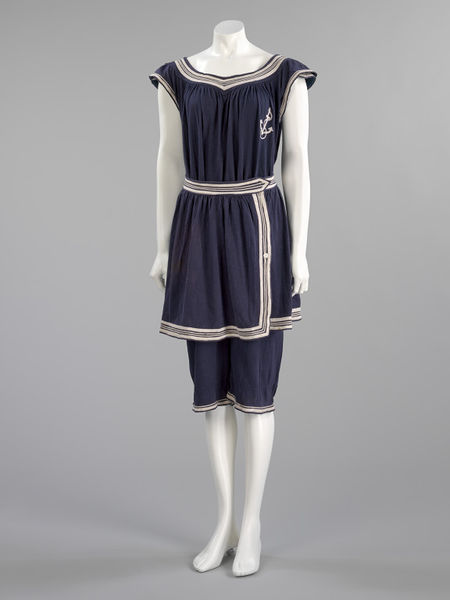
This bathing costume and skirt are made from navy wool and decorated with applied work of stripes and an anchor. The costume was made in England around 1910 and is typical of its era. Mainstream British society’s understanding of appropriate feminine modesty meant that women’s swimwear tended to be knee length and non-fitted, and to feature skirts. Such ensembles were not particularly practical, yet nineteenth-century British swimwear for women had been notably longer and bulkier, and women had often entered the sea in bathing machines (wooden carts which could be rolled into the water). Wool, flexible if easily waterlogged, was usually the fibre of choice in both the nineteenth century and the early twentieth century, and nautical motifs were all the rage.
2) Meridian Bathing Costume T.307-1992, ca. 1925
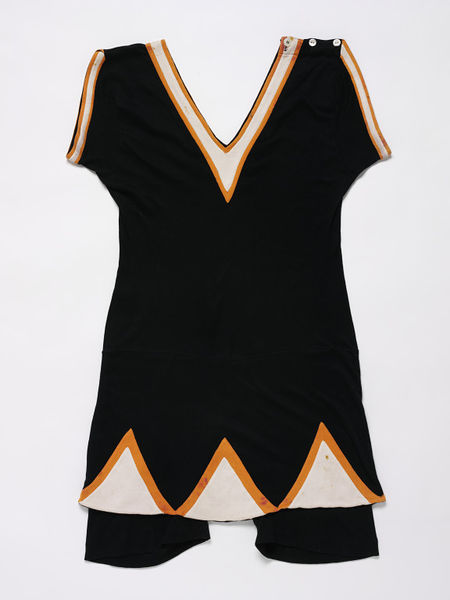
By the 1920s, when this British bathing costume was made, many women in Britain and elsewhere were not expected to cover up to the same extent as they had been in earlier periods, but the short attached skirt pictured above emphasises the fact that exposed women’s bodies often continued to cause concern. This costume differs from the ca. 1910 example in terms of material and motif as well as length. It’s made from relatively lightweight cotton jersey and decorated with orange and white stripes and Art Deco style triangles. It’s also significant that this bathing suit, unlike the first discussed, was made and marked by a well-known company: Meridian. Branding became increasingly important to fashion as the twentieth century, with its proliferation of advertising campaigns, progressed.
3) Neyret for Galeries Lafayette Bathing Costume T.293-1971, 1937
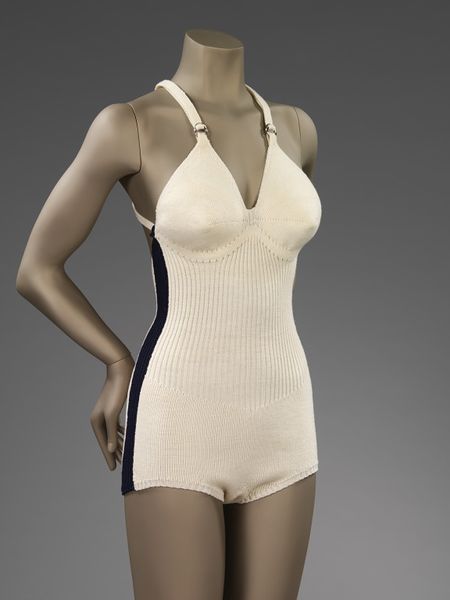
This swimsuit was made in France in the 1930s, when swimming and other outdoor activities became newly popular as a result of a growing interest in health and particularly fitness, apparently connected to various nations’ desire for their people to be ready for another war. But the costume interestingly has much in common with the first swimsuit discussed. It’s made from wool, which was still considered to be a suitable, if flawed, material for swimwear. And it’s white and navy, if more subtly nautical than many earlier bathing costumes. However, this swimming costume is close fitting, particularly due to the ribbed waist panel, and reveals more of the body. The skirt and sleeves have disappeared, the back is low, and the bust area is prominent, partly because it’s been fashioned. Many designers were responding to calls for functional sportswear and shifting understandings of feminine modesty and the fashionable silouette in various places. Additionally, this costume’s straps are adjustable, to allow for tanning, which became popular at around the same time as fitness. And the swimsuit is branded. It was made by Neyret for Galeries Lafayette, a French department store in London.
4) Finnigans Ltd. Bathing Suit T.294&A-1971, 1937-1939
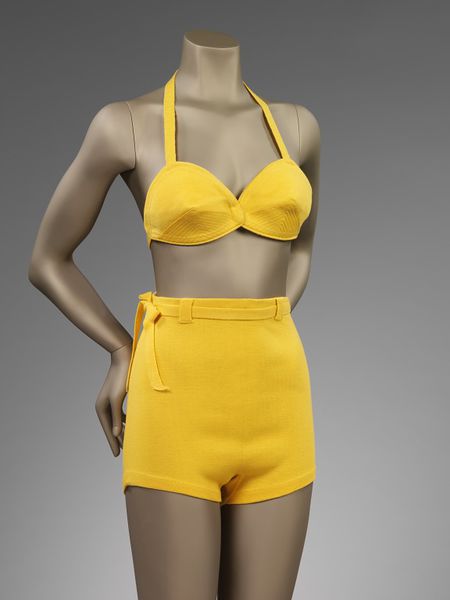
This wool jersey bathing suit was made around the same time as the Neyret costume, but it’s a fairly early example of a clearly two-piece women’s swimming costume, and it exposes more midriff than most pre-World War II bikinis. Wartime shortages encouraged the production of increasingly revealing two pieces, although French designers Jacques Heim and Louis Réard are often credited with introducing the modern bikini, characterised by its minimal size, in 1946. Heim named his creation Atome, after the smallest known particle of matter, but it was Réard’s term, taken from Bikini Atoll (the atoll in the Marshall Islands from which people were removed in 1946 so that atomic-weapons tests could be carried out by the United States), that stuck. The bikini, particularly its post-war incarnation, provoked both adulation and horror. Around mid-century many people viewed bikinis as attractive yet immodest, while feminists could associate them with either freedom or sexual objectification.
5) Bimba Bathing Costume T.367-1996, ca. 1955
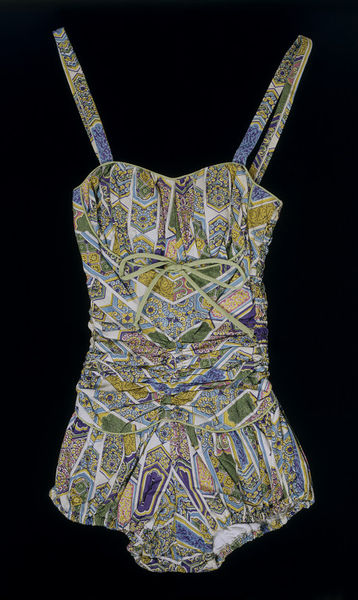
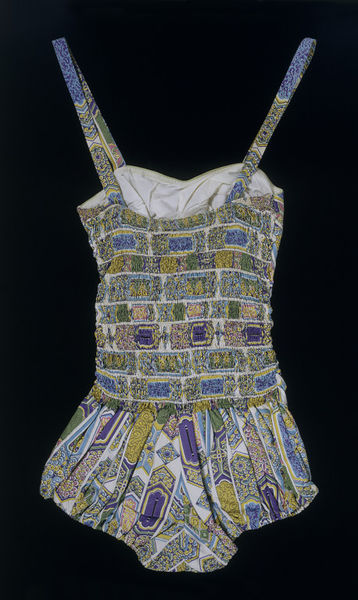
It is perhaps unsurprising, then, that many women bathers continued to wear one pieces in the 1950s—costumes like the one pictured above, which was made in Australia around 1955. This swimming costume is striking for its multi-coloured, elaborate pattern, which has been printed on to cotton, and for its elastic-ruched back. Technological advances had made such designs possible, and 1950s swimming costumes for women commonly had much in common with fashionable womenswear of the day, which was often reacting against the new freedoms that many women had grasped during the war, and the unfeminine clothes that some of them had worn. Thus women’s swimwear often featured feminine patterns and sculpted the body, cinching waists and emphasising breasts. Many people were enjoying more leisure time in the post-war period, so women often owned a collection of swimming costumes akin to this one.
6) Swimsuit T.80-2015, 1970s
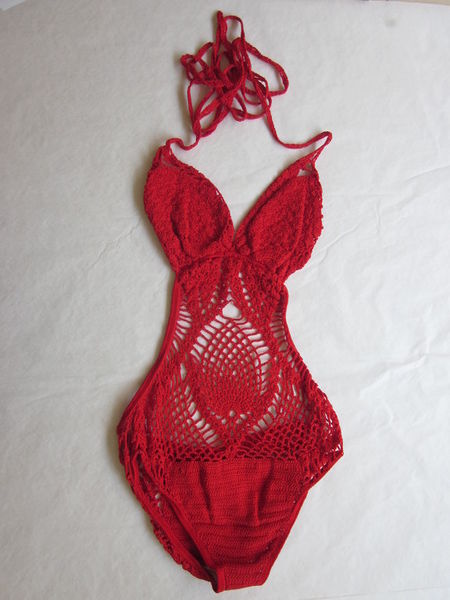
Functional, low-drag swimsuits which were highly elastic and durable were widely available by the 1970s. Thanks largely to nylon/elastane, numerous swimming records were broken at the 1972 Olympics. Yet many bathers prioritised fashion over functionality. This striking 1970s swimming costume, which is a hybrid between a one piece and a bikini, resembles clothes which were popular during this decade, being crocheted out of bright wool yarn.
7) Stella McCartney for Adidas Olympic Swimsuit T.67-2016, 2012
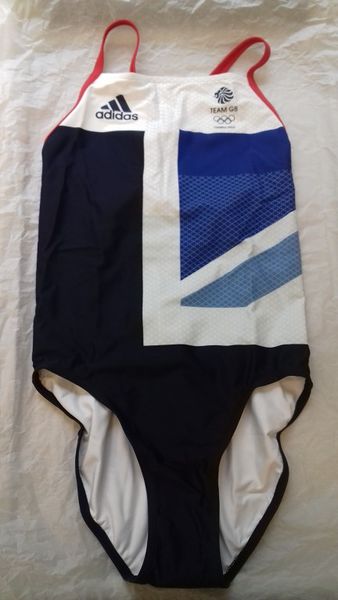
Speaking of the Olympics, Stella McCartney designed this swimsuit, along with a range of sportswear items, for the 2012 Olympics. She worked in partnership with Adidas. The company had produced Team GB (the Great Britain and Northern Ireland Olympic Team run by the British Olympic Association) kit since 1984, but they had not previously worked with a leading fashion designer. Together they made pieces which combined cutting-edge technology with high-quality creative design. This costume is made from synthetic blended fabric, and its main feature is a stylised partial Union Jack in interesting textures. It’s notably shorter than the women’s swimsuits worn by members of Team GB in the previous Olympics, because full-length high-tech swimsuits were banned in 2012, and again in 2016.
It may be rather chilly out there, but perhaps this has inspired you to go for a swim, or to book an appointment to visit the Clothworkers’ Centre!
If you’re interested in making an appointment to view textiles and fashion objects at the Clothworkers’ Centre, please email clothworkers@vam.ac.uk.
This post was edited by the author on 21 December 2020 as part of work on sensitive terminology and topics. Some additional edits were made at the same time to further improve the post.


